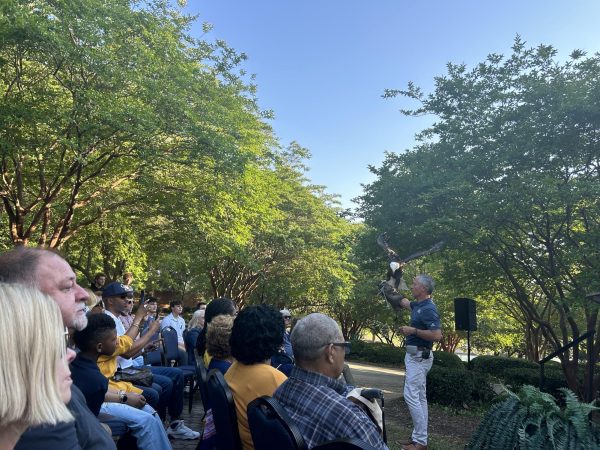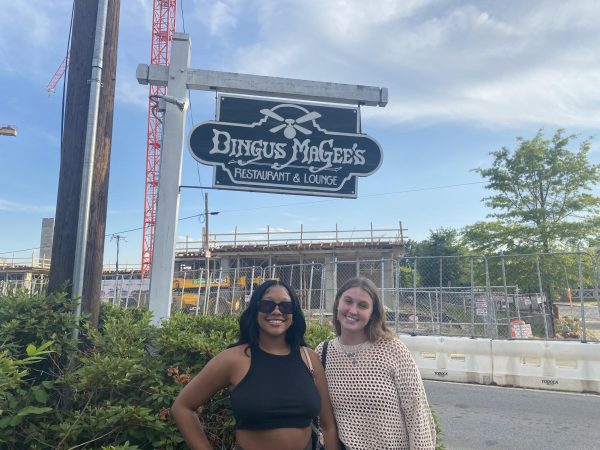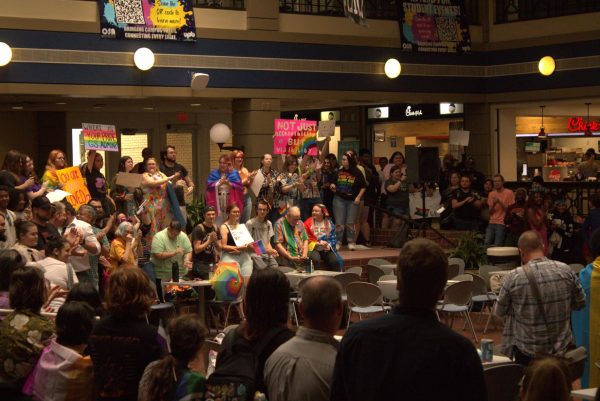Site-synchronous classroom to unite Georgia Southern campuses
May 1, 2019
The first semester of the pilot program for site-synchronous classrooms implemented across all three Georgia Southern University campuses is coming to a close, but the classrooms will continue to be available.
Dustin Anderson, Faculty Senate president and associate professor of literature, said the technology used to mediate communication between the three campuses is called the Cisco Kodek.
The Cisco Kodek is hardware that implements a dynamic camera that is able to locate and zoom-in on whoever is speaking, creating a more natural transaction on screen that helps minimize the perceived distance from users, Anderson said.
The process is similar to that of a video call, such as with Skype or FaceTime, except the A.I. is more intuitive and feels more like a real face-to-face experience. Each campus has one Cisco Kodek, and the technology is only used for two campuses at a time.
“What we wanted to do was make sure that our students felt like they still had more or less a face-to-face classroom feel,” Anderson said. “A big part of the educational experience is hearing what your classmates have to say and being in that space with them. It’s how you form communities. You build identity as a class.”
The site-synchronous classrooms were created and implemented as a result of Anderson collaborating with Information Technology Services to develop a way for multi-campus faculty senate meetings to happen without anyone having to drive too far, Anderson said.
At the beginning of the spring 2019 semester, the technology began being implemented for three different classes, with one of them being Anderson’s “Liars, Guns and Money” class for both Statesboro and Liberty campuses. Anderson said that he sees the dual-campus students as one unified class.
Anderson said that the microphones are highly sensitive, and will pick up whispers from students as well as side conversations that were not intended to be heard by the entire class, which has resulted in more students passing notes and some funny scenarios over the semester.
“A couple of really interesting questions popped up this way that people didn’t realize they were asking,” Anderson said. “[A student] kind of had leaned over and asked the person next to her, and it sounded like a regular question, so I just answered it. And [she was like], ‘Oh my God, I didn’t mean to ask that out loud.’ One of the students on that side went, ‘Oh my God, the microphones are telepathic. They’re in our heads,’ and it was kind of funny in the moment.”
Student roles have also developed due to the new technology, Anderson said. One student was dubbed the “moral center” because of her outlook on life, and students in his class were addressing her across the screen to get her take on certain topics during discussions.
“What it means is that the classroom is really de-centralized,” Anderson said. “It’s not dependent solely on the professor there saying, ‘I’m the only person that knows something,’ so we’ve kind of built some of those relationships in that class that way people are okay to jump across and ask that out, so that was entertaining.”
Anderson said that the site-synchronous classrooms’ best endorsement is that it is not invasive, and that it is almost exactly like attending a face-to-face class. The technology is likely here to stay.
Another benefit in using the new technology is that less students will have to travel far to take classes that they are interested in, Anderson said.
“You’re paying for the class already,” Anderson said. “You’ve made an investment financially. You’ve made an investment in time. I don’t want that over-investment to be there. I’d rather the students, rather than driving for two hours, reading more, studying more, talking with their classmates about things.”
Elizabeth Gross, The George-Anne News Reporter, ganewsed@georgiasouthern.edu














